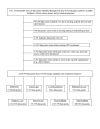Methodological differences between studies confound one-size-fits-all approaches to managing surface waterways for food and water safety
- PMID: 38214516
- PMCID: PMC10880618
- DOI: 10.1128/aem.01835-23
Methodological differences between studies confound one-size-fits-all approaches to managing surface waterways for food and water safety
Abstract
Even though differences in methodology (e.g., sample volume and detection method) have been shown to affect observed microbial water quality, multiple sampling and laboratory protocols continue to be used for water quality monitoring. Research is needed to determine how these differences impact the comparability of findings to generate best management practices and the ability to perform meta-analyses. This study addresses this knowledge gap by compiling and analyzing a data set representing 2,429,990 unique data points on at least one microbial water quality target (e.g., Salmonella presence and Escherichia coli concentration). Variance partitioning analysis was used to quantify the variance in likelihood of detecting each pathogenic target that was uniquely and jointly attributable to non-methodological versus methodological factors. The strength of the association between microbial water quality and select methodological and non-methodological factors was quantified using conditional forest and regression analysis. Fecal indicator bacteria concentrations were more strongly associated with non-methodological factors than methodological factors based on conditional forest analysis. Variance partitioning analysis could not disentangle non-methodological and methodological signals for pathogenic Escherichia coli, Salmonella, and Listeria. This suggests our current perceptions of foodborne pathogen ecology in water systems are confounded by methodological differences between studies. For example, 31% of total variance in likelihood of Salmonella detection was explained by methodological and/or non-methodological factors, 18% was jointly attributable to both methodological and non-methodological factors. Only 13% of total variance was uniquely attributable to non-methodological factors for Salmonella, highlighting the need for standardization of methods for microbiological water quality testing for comparison across studies.IMPORTANCEThe microbial ecology of water is already complex, without the added complications of methodological differences between studies. This study highlights the difficulty in comparing water quality data from projects that used different sampling or laboratory methods. These findings have direct implications for end users as there is no clear way to generalize findings in order to characterize broad-scale ecological phenomenon and develop science-based guidance. To best support development of risk assessments and guidance for monitoring and managing waters, data collection and methods need to be standardized across studies. A minimum set of data attributes that all studies should collect and report in a standardized way is needed. Given the diversity of methods used within applied and environmental microbiology, similar studies are needed for other microbiology subfields to ensure that guidance and policy are based on a robust interpretation of the literature.
Keywords: Listeria; Salmonella; methods comparison; produce safety; shiga toxin Escherichia coli; water quality.
Conflict of interest statement
The authors declare no conflict of interest.
Figures





Similar articles
-
The probability of detecting host-specific microbial source tracking markers in surface waters was strongly associated with method and season.Microbiol Spectr. 2025 Feb 4;13(2):e0197224. doi: 10.1128/spectrum.01972-24. Epub 2024 Dec 17. Microbiol Spectr. 2025. PMID: 39688392 Free PMC article.
-
Molecular ecology of Listeria spp., Salmonella, Escherichia coli O157:H7 and non-O157 Shiga toxin-producing E. coli in pristine natural environments in Northern Colorado.J Appl Microbiol. 2018 Feb;124(2):511-521. doi: 10.1111/jam.13657. J Appl Microbiol. 2018. PMID: 29215770
-
Complex Interactions Between Weather, and Microbial and Physicochemical Water Quality Impact the Likelihood of Detecting Foodborne Pathogens in Agricultural Water.Front Microbiol. 2020 Feb 6;11:134. doi: 10.3389/fmicb.2020.00134. eCollection 2020. Front Microbiol. 2020. PMID: 32117154 Free PMC article.
-
Prevalence of foodborne pathogens in food from selected African countries - A meta-analysis.Int J Food Microbiol. 2017 May 16;249:35-43. doi: 10.1016/j.ijfoodmicro.2017.03.002. Epub 2017 Mar 6. Int J Food Microbiol. 2017. PMID: 28271855 Review.
-
Microbiological safety evaluations and recommendations on sprouted seeds. National Advisory Committee on Microbiological Criteria for Foods.Int J Food Microbiol. 1999 Nov 15;52(3):123-53. doi: 10.1016/s0168-1605(99)00135-x. Int J Food Microbiol. 1999. PMID: 10733245 Review.
Cited by
-
The probability of detecting host-specific microbial source tracking markers in surface waters was strongly associated with method and season.Microbiol Spectr. 2025 Feb 4;13(2):e0197224. doi: 10.1128/spectrum.01972-24. Epub 2024 Dec 17. Microbiol Spectr. 2025. PMID: 39688392 Free PMC article.
References
-
- Food and Drug Administration . 2019. Environmental assessment of factors potentially contributing to the contamination of Romaine lettuce implicated in a multi-state outbreak of E. coli. Available from: https://www.fda.gov/food/outbreaks-foodborne-illness/environmental-asses...
-
- Graciaa DS, Cope JR, Roberts VA, Cikesh BL, Kahler AM, Vigar M, Hilborn ED, Wade TJ, Backer LC, Montgomery SP, Secor WE, Hill VR, Beach MJ, Fullerton KE, Yoder JS, Hlavsa MC. 2018. Outbreaks associated with untreated recreational water—United States. MMWR Morb Mortal Wkly Rep 67:701–706. doi:10.15585/mmwr.mm6725a1 - DOI - PMC - PubMed
-
- Greene SK, Daly ER, Talbot EA, Demma LJ, Holzbauer S, Patel NJ, Hill TA, Walderhaug MO, Hoekstra RM, Lynch MF, Painter JA. 2008. Recurrent multistate outbreak of Salmonella Newport associated with tomatoes from contaminated fields, 2005. Epidemiol Infect 136:157–165. doi:10.1017/S095026880700859X - DOI - PMC - PubMed
-
- Lee SH, Levy DA, Craun GF, Beach MJ, Calderon RL. 2002. Surveillance for waterborne-disease outbreaks--United States, 1999-2000. Morb Mortal Wkly Rep Surveillance summaries 51:1–47. - PubMed
Publication types
MeSH terms
Grants and funding
LinkOut - more resources
Full Text Sources
Miscellaneous

